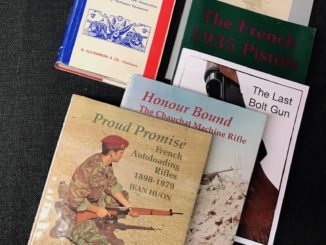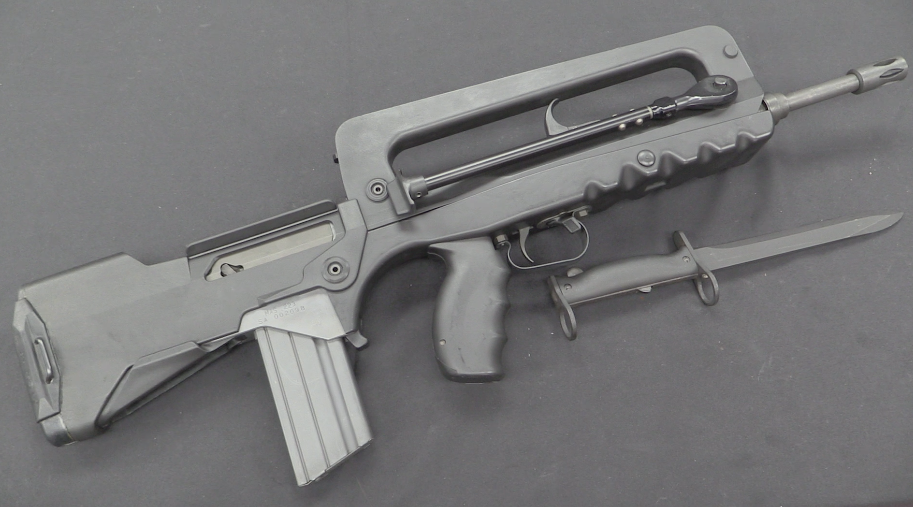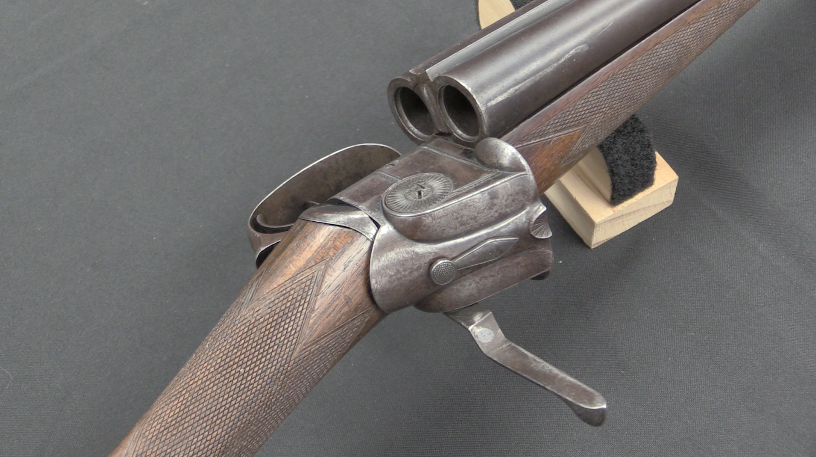I’m working on getting a Hotchkiss 1914 heavy machine gun up and running for some long range accuracy testing. It’s not quite ready yet, but I saw a very interesting effect of the WW1 muzzle device (used on both the Hotchkiss 1914 and the St Etienne 1907 machine guns) in use…
Related Articles

Book review
Literature Review: English-Language Books on French Firearms
Since we are in the middle of a series on French rifles, I figured it would be an appropriate time to take a look at what printed reference books are out there in English on […]

Semiauto Rifles
RIA: Semiauto FAMAS
The French FAMAS was one of the first bullpup rifles to be adopted and built in large numbers by a military power. It was adopted by France in 1978 at right about the same time […]

Shotgun
RIA: Darne 1892 Rotary Shotgun
The most popular shotgun made by the French Darne company was their 1897 sliding breech side-by-side, which saw sales and use worldwide. Before that, however, Darne invented a rotating breechblock system – first a series […]

As a gun intended for use in deserts wetting the ground under the muzzle would not be good, but would it work to reduce the dust cloud? Would a blanket or piece of canvas?
Sand bags would help, I think.
As would a trench or pit dug into the ground. You should expect a heavy machine gun to get some form of protection as it will be a priority target for the other team, especially if they toss explosives at your face! Is there a second gun to prevent flanking? I could be wrong…
Even more entertaining would be firing the bugger from a machine gun post in a trench.
No matter how many “posed” photographs of the time showed machine guns set up in the open, in actual practice the gun’s muzzle was poking over the parapet, usually through a sandbagged revetment, and never more than a few inches off the ground at most. Because having it any higher was a certain invitation to an alert German with a rifle to blow the gunner’s head off before he could fire.
Now imagine this thing’s effect if the muzzle is less than a foot from the dirt, rather than three feet up. The Colt Model 1895 “Potato Digger’s” effect with its swinging actuating rod would be nothing compared to what this unholy beast would throw in the gunner’s face. I’d expect rocks to be tossed in interesting directions with near-lethal velocity.
I suspect that the “cowcatcher” muzzle device was issued to French Hotchkiss HMG crews about the way the Hale MK I hand grenade was issued to British troops. And like the Hale grenade, once its shortcomings when used from a slit trench became obvious, the “cowcatcher” was withdrawn about as fast as the Hale MK I grenade was modified into the shorter-handled MK II.
cheers
eon
Maybe this was a tricky masking method – hide in cloud of dust!
Using a cloud of dust as a hiding spot would require you to wear a gas mask or a bandana. Plus, you had better make sure the other team doesn’t have a field gun trained on your position.
Ian, be very careful going down the rabbit hole of Machine Gun Theory!
Nek minut Forgotten Weapons becomes ‘Forgotten SFMGs’
Yep,
Tripod legs to be pegged to the ground with sand bag ballast bags.
Direct fire, indirect fire, single guns, batteries of guns, optics, iron sights, rates of fire, ammunition belt make up, observers, fire correction, crew size, mobile or fixed positions and so on.
It’s not just a rabbit hole it’s a very large set of interconnected burrows and depends heavily on the countries docterine for use.
We also have to be very careful about applying “modern” concepts and understandings in interpreting/replicating historic practices.
Enough waffle lets get back to enjoying the guns
Wow, that’s a shirt!
It got my attention too. Ian has daring fashion inclinations (may be a present). I like it!
I enjoy any information on Hotchkiss 1914; they were incredibly avantgarde for their time. In video from April of last year I can see more conventional conical flash hider. What happened with it? Was it later development?
I am happy to see Ian found liking in it.
A supplementary question: was this gun adopted for Springfield 30.06 shot? I believe U.S. troops brought some home with them.
The Hotchkiss Portative in .30-06 was in U.S. Army service before we entered the war. See “Benet-Mercie Machine Rifle Model 1909”.
Yes, these were the famous “Daylight Guns” of the Villista raid on Columbus, NM on the night of 8-9 March 1916. Far from being ineffective as the newsrags said, the four guns in the hands of National Guard troops fired over 20,000 rounds and accounted for roughly 80% of the casualties Villa’s forces suffered.
The Villistas attacked the town with about 480 riders; they lost about 170 killed, another 200 wounded, and 7 captured, six of whom were hanged. American losses were 10 dead and 30+ wounded, mostly civilians shot in the first five minutes of the attack.
I’d say the term “Daylight Guns” would be an accurate description of what the M1909s did to the Villistas, as in “let daylight through ’em”.
According to Gen. Julian Hatcher in Hatcher’s Notebook, he ran a training course on the M1909 and the then brand-new Lewis Gun at Ft. Hood about that time. He stated that when he arrived, every soldier in the MG sections hated the M1909, and they were all enthused about the heavier Lewis Gun. By the time he got done training them correctly on both (like cocking the Hotchkiss correctly, which the manual had screwed up royally) every single gun team preferred the M1909.
BTW, a version of the Hotchkiss was the first genuine “heavy machine gun”, meaning one of greater than rifle caliber. It was made in 11 x 59 Gras smokeless (aka 11 x 59 Vickers) as an anti-observation balloon gun, firing incendiary bullets, because the incendiary compositions of the time didn’t work very well in a 7mm to 8mm projectile.
cheers
eon
“(…)enjoy any information on Hotchkiss 1914(…)”
VHU seems to have at least one specimen: http://www.vhu.cz/exhibit/francouzsky-tezky-kulomet-hotchkiss-mle-1914/
interestingly there is what seems to be vintage marketing photo – with this machine gun described as Mitrailleuse sur affût fixe. – it does not have any muzzle device, sadly I do not know from which year this photo is.
In my limited experience with them, traditional conical and cylindrical flash hiders’ primary effect is to reduce illumination to the rear and sides (lighting you up and blinding you) but do rather less to reduce visibility from the front, unlike modern cool-the-gasses flash suppressors that reduce the illumination generally. This device has always struck me as an attempt to generally conceal the muzzle flash from the enemy, probably in response to the same Good Idea Fairy that inspired the rest of the disastrous 1907 attempt to evade the Hotchkiss patents. One can likely only test this in low light conditions. The rest of the unintended effects on barrel dynamics can likely seen on targets at sufficient range, or possibly in high-speed photography, in mounted/unmounted comparison.
The device was intended to be used in fortification mountings rather than field entrenchments. It is designed to deflect gases away from the interior of a casemate. It was fitted to other HMG’s used by the French Army at the time such as the St Etienne(Source: Pg 70, Gander, Terry. “Machine Guns”, The Crowood Press, Wiltshire, 2003.)
Here is one at the Musée de l’Armée (in the Hôtel des Invalides in Paris) in Paris: https://www.flickr.com/photos/matisse-enzer/24678863289/in/album-72157664722003265/
Oh !! This is a really great article. Thank you for providing these details. I’m sad I didn’t even know about this.
See also: https://www.forgottenweapons.com/spoils-of-war-a-1907-st-etienne-full-of-bullet-holes/ for another example of this muzzle device. “A 1907 St Etienne Full of Bullet Holes”
I’m working on getting a Hotchkiss 1914 heavy machine gun up and running for some long range accuracy testing. It’s not quite ready yet.